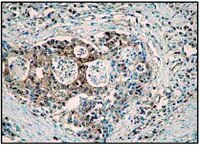The endoplasmic reticulum stress inhibitor salubrinal inhibits the activation of autophagy and neuroprotection induced by brain ischemic preconditioning.
Gao, B; Zhang, XY; Han, R; Zhang, TT; Chen, C; Qin, ZH; Sheng, R
Acta pharmacologica Sinica
34
657-66
2013
Show Abstract
To investigate whether endoplasmic reticulum (ER) stress participates in the neuroprotective effects of ischemic preconditioning (IPC)-induced neuroprotection and autophagy activation in rat brains.The right middle cerebral artery in SD rats was occluded for 10 min to induce focal cerebral IPC, and was occluded permanently 24 h later to induce permanent focal ischemia (PFI). ER stress inhibitor salubrinal (SAL) was injected via intracerebral ventricle infusion 10 min before the onset of IPC. Infarct volume and motor behavior deficits were examined after the ischemic insult. The protein levels of LC3, p62, HSP70, glucose-regulated protein 78 (GRP 78), p-eIF2α and caspase-12 in the ipsilateral cortex were analyzed using immunoblotting. LC3 expression pattern in the sections of ipsilateral cortex was observed with immunofluorescence.Pretreatment with SAL (150 pmol) abolished the neuroprotective effects of IPC, as evidenced by the significant increases in mortality, infarct volume and motor deficits after PFI. At the molecular levels, pretreatment with SAL (150 pmol) significantly increased p-eIF2α level, and decreased GRP78 level after PFI, suggesting that SAL effectively inhibited ER stress in the cortex. Furthermore, the pretreatment with SAL blocked the IPC-induced upregulation of LC3-II and downregulation of p62 in the cortex, thus inhibiting the activation of autophagy. Moreover,SAL blocked the upregulation of HSP70, but significantly increased the cleaved caspase-12 level, thus promoting ER stress-dependent apoptotic signaling in the cortex.ER stress-induced autophagy might contribute to the neuroprotective effect of brain ischemic preconditioning. | 23603983
 |
Autophagy regulates endoplasmic reticulum stress in ischemic preconditioning.
Rui Sheng,Xiao-Qian Liu,Li-Sha Zhang,Bo Gao,Rong Han,Ying-Qiu Wu,Xiang-Yang Zhang,Zheng-Hong Qin
Autophagy
8
2011
Show Abstract
Recent studies have suggested that autophagy plays a prosurvival role in ischemic preconditioning (IPC). This study was taken to assess the linkage between autophagy and endoplasmic reticulum (ER) stress during the process of IPC. The effects of IPC on ER stress and neuronal injury were determined by exposure of primary cultured murine cortical neurons to 30 min of OGD 24 h prior to a subsequent lethal OGD. The effects of IPC on ER stress and ischemic brain damage were evaluated in rats by a brief ischemic insult followed by permanent focal ischemia (PFI) 24 h later using the suture occlusion technique. The results showed that both IPC and lethal OGD increased the LC3-II expression and decreased p62 protein levels, but the extent of autophagy activation was varied. IPC treatment ameliorated OGD-induced cell damage in cultured cortical neurons, whereas 3-MA (5-20 mM) and bafilomycin A 1 (75-150 nM) suppressed the neuroprotection induced by IPC. 3-MA, at the dose blocking autophagy, significantly inhibited IPC-induced HSP70, HSP60 and GRP78 upregulation; meanwhile, it also aggregated the ER stress and increased activated caspase-12, caspase-3 and CHOP protein levels both in vitro and in vivo models. The ER stress inhibitor Sal (75 pmol) recovered IPC-induced neuroprotection in the presence of 3-MA. Rapamycin 50-200 nM in vitro and 35 pmol in vivo 24 h before the onset of lethal ischemia reduced ER stress and ischemia-induced neuronal damage. These results demonstrated that pre-activation of autophagy by ischemic preconditioning can boost endogenous defense mechanisms to upregulate molecular chaperones, and hence reduce excessive ER stress during fatal ischemia. | 22361585
 |
Characterization of seven murine caspase family members.
Van de Craen, M, et al.
FEBS Lett., 403: 61-9 (1997)
1997
Show Abstract
Seven members of the murine caspase (mCASP) family were cloned and functionally characterized by transient overexpression: mCASP-1 (mICE), mCASP-2 (Ich1), mCASP-3 (CPP32), mCASP-6 (Mch2), mCASP-7 (Mch3), mCASP-11 (TX) and mCASP-12. mCASP-11 is presumably the murine homolog of human CASP-4. Although mCASP-12 is related to human CASP-5 (ICErel-III), it is most probably a new CASP-1 family member. On the basis of sequence homology, the caspases can be divided into three subfamilies: first, mCASP-1, mCASP-11 and mCASP-12; second, mCASP-2; third, mCASP-3, mCASP-6 and mCASP-7. The tissue distribution of the CASP-1 subfamily transcripts is more restricted than that of the CASP-3 subfamily transcripts, suggesting that the transcriptional regulation of the CASP members within one subfamily is related, but is quite different between the CASP-1 and the CASP-3 subfamilies. Transient overexpression of each of the seven CASPs induced apoptosis in mammalian cells. Only two, mCASP-1 as well as mCASP-3, were able to process precursor interleukin (IL)-1beta to biologically active IL-1beta. In addition, mCASP-3 is the predominant PARP-cleaving enzyme in vivo. | 9038361
 |
Production of matrix metalloproteinases and tissue inhibitor of metalloproteinases-1 by human brain tumors.
Nakagawa, T, et al.
J. Neurosurg., 81: 69-77 (1994)
1993
Show Abstract
The role of matrix metalloproteinases (MMP's) and their inhibitor, tissue inhibitor of metalloproteinases-1 (TIMP-1), in human brain tumor invasion was investigated. Gelatinolytic activity was assayed via gelatin zymography, and four MMP's (MMP-1, MMP-2, MMP-3, and MMP-9) and TIMP-1 were immunolocalized in human brain tumors and in normal brain tissues using monoclonal antibodies. The tissue was surgically removed from 44 patients: glioblastoma (five cases), anaplastic astrocytoma (six cases), astrocytoma (four cases), metastatic tumor (six cases), neurinoma (10 cases), meningioma (10 cases), and normal brain tissue (three cases). Glioblastomas, anaplastic astrocytomas, and metastatic tumors showed high gelatinolytic activity and positive immunostaining for MMP's; TIMP-1 was also expressed in these tumors, but some tumor cells were negative for the antibody. Astrocytomas had low gelatinolytic activity and the tumor cells showed no immunoreactivity for MMP's and TIMP-1. Although neurinomas and meningiomas had only moderate proteinase activity and exhibited positive immunoreactivity for MMP-9, intense expression of TIMP-1 was simultaneously observed in these tumor cells. These findings suggest that MMP's play an important role in human brain tumor invasion, probably due to an imbalance between the production of MMP's and TIMP-1 by the tumor cells. | 8207529
 |













